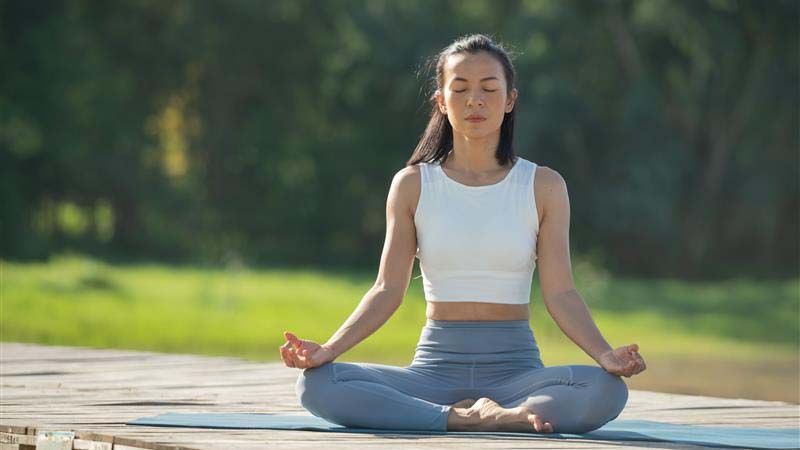Standing For Hours Feels Like A Workout.. But Is It?
- 27 months ago
In a world where most of us find ourselves glued to chairs for hours on end, standing for extended periods may seem like a refreshing departure from the sedentary norm. But does standing for several hours truly equate to a bona fide workout?
The idea of standing as a form of exercise seems plausible. After all, it requires a constant engagement of the muscles to maintain balance and stability, and it certainly beats sitting in terms of energy expenditure. But is it enough? Are we truly reaping the rewards of a workout when we choose to remain upright for extended periods?
While standing for a long period might be physically challenging and contribute to higher energy expenditure when compared to sitting or sedentary activities, it isn't usually considered a formal workout in the traditional sense.
Standing isn't a workout, but are there any benefits to doing it for long durations?
Standing alone does not considerably raise your heart rate or challenge your cardiovascular system in the same way that aerobic exercises such as jogging, cycling, or swimming do. These exercises are essential for improving heart health, boosting stamina, and enhancing overall endurance.
Moreover, while standing engages the muscles of your lower body to some extent, it lacks the necessary resistance and intensity to effectively strengthen and build muscle mass. Unlike targeted strength training exercises that involve weights, resistance bands, or bodyweight movements, standing alone falls short of providing the stimulus required for significant muscle development.
You may also like: Burn calories while watching television
The Upsides of Standing
- Increased Caloric Expenditure: Standing does burn more calories compared to sitting, albeit not as much as vigorous physical activity. While sitting burns around 60-80 calories per hour, standing can raise that number to approximately 120 calories per hour (may vary person to person). Over an extended period, this incremental energy expenditure can contribute to weight management and a healthier metabolism.
- Enhanced Posture and Core Engagement: Standing encourages better posture, as it requires engagement from the core muscles to maintain stability. By avoiding the slouched position often associated with sitting, standing can help strengthen the core, back, and leg muscles. Over time, this can alleviate back pain and improve overall posture, making you feel more energetic and less fatigued.
- Improved Circulation: Standing stimulates blood flow and prevents blood from pooling in the lower extremities, reducing the risk of developing deep vein thrombosis (DVT). It also encourages muscle contractions in the legs, acting as a natural pump to push blood back to the heart. This increased circulation can improve cardiovascular health and reduce the likelihood of related conditions.
You can try: Plow pose: Ground your body & improve circulation
The Limitations of Standing
- Insufficient Muscular Activation: Although standing requires some muscle engagement, it falls short of the intensity and variety of movements provided by actual exercise. While standing may be better than sitting, it lacks the cardiovascular benefits, full-body strength training, and flexibility that structured workouts offer.
- Static Load on Joints: Standing for prolonged periods can lead to joint discomfort and fatigue, especially in the knees, hips, and ankles. Without the dynamic movements and varied positions found in exercise, continuous static loading can strain joints and contribute to musculoskeletal issues. It's crucial to incorporate regular breaks, stretches, and movement to mitigate these risks.
- Inadequate Cardiovascular Stimulation: Standing alone does not provide sufficient cardiovascular exercise to improve heart health or endurance. Activities like walking, jogging, or cycling that elevate the heart rate for a sustained period are necessary for a comprehensive cardiovascular workout.
How to deal with soreness from standing?
Dealing with soreness from standing for extended periods can be a common issue, despite it not being considered a formal workout. So, what causes this discomfort? The reasons can vary from muscle fatigue and lack of movement to poor posture. When you stand for long durations, your muscles constantly work to maintain an upright posture and support your body weight, resulting in soreness and discomfort.
One of the main culprits of soreness from prolonged standing is being in one position for an extended period. This lack of movement restricts blood flow and reduces muscle contractions, leading to the buildup of waste products like lactic acid in the muscles. This accumulation contributes to soreness and stiffness.
Here are a few strategies to alleviate discomfort and promote muscle recovery:
- Maintain good posture: Stand with proper alignment to minimize strain on muscles.
- Wear supportive shoes: Choose comfortable footwear with adequate arch support.
- Stretch gently: Perform targeted stretches for calves, thighs, and lower back.
- Apply heat or cold: Use heat packs or cold therapy to reduce soreness and inflammation.
- Use self-massage tools: Foam rollers or massage balls can help alleviate muscle tension.
- Gradually increase standing time: Build endurance by gradually increasing standing duration.
You may also like: Soreness after yoga? This is what your body needs

Conclusion
Standing for several hours may not be a comprehensive substitute for a workout, but it does offer some advantages over prolonged sitting. The increased caloric expenditure, enhanced posture, and improved circulation associated with standing are undoubtedly beneficial. However, it's crucial to recognize the limitations and ensure a well-rounded approach to physical activity that incorporates structured exercise and regular movement breaks. By finding the right balance, you can optimize your health, energy levels, and overall quality of life.









